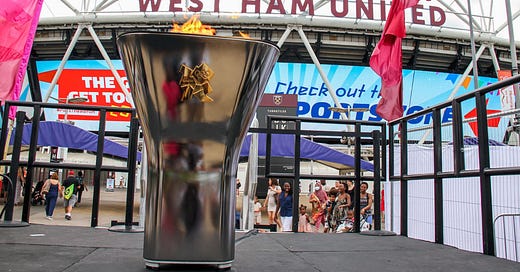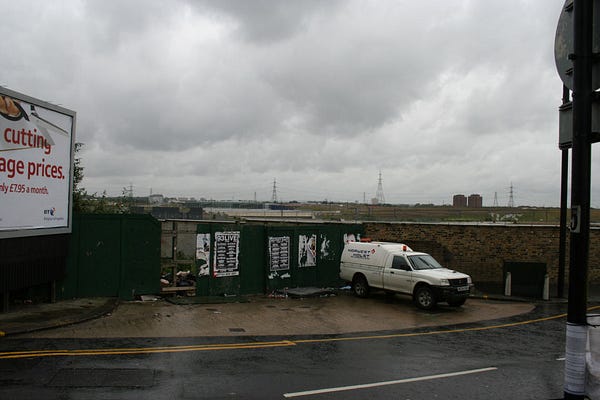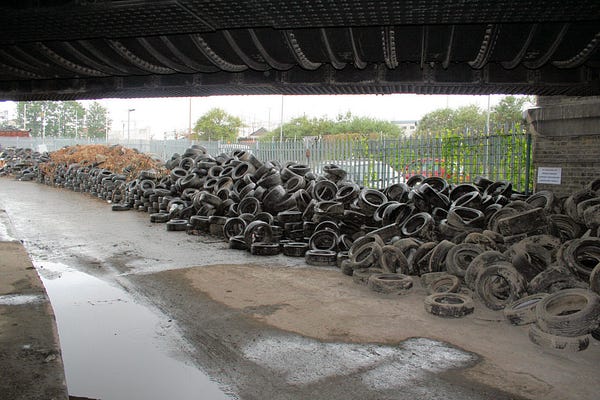Thanks for reading Off to Lunch. If this newsletter was shared with you please sign-up below to get Off to Lunch sent directly to your inbox, attend our events and contribute to our work
Wednesday July 27th is the tenth anniversary of the opening ceremony of the London 2012 Olympics. The day is being celebrated and remembered widely on social media…





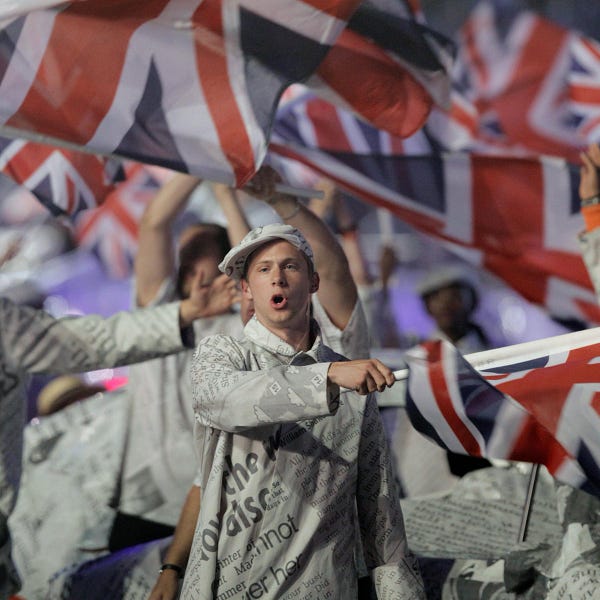

That summer was a brilliant time to be in Britain and London. People were nice to each other on the tube and offered help to lost tourists, station announcements told you who had won the latest medal, and there were sporting moments that still give me goosebumps when I think about them. Aside from the Team GB stories, the one that sticks in my mind is David Rudisha setting a new world record in the 800 metres, a record which still stands today. That race was so fast that the runner in last place ran a time that would have won gold at the Tokyo Olympics last year…

Anyway, the anniversary has also prompted lots of analysis about the legacy of London 2012, its £9 billion budget and whether its pledge to “Inspire a generation” has become a reality. There has been a mixed reaction to this, as you can see below:

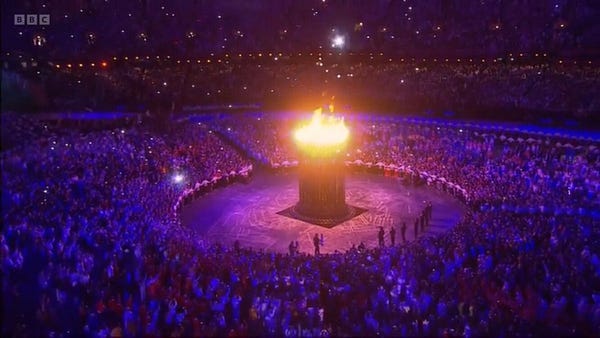



I want to focus on the legacy left in the area where the Olympics was held - Stratford, east London. I have lived in a flat in this area for the last eight years and many editions of this newsletter have been written from a desk at Plexal, a co-working space which was the press centre during London 2012. I have seen first-hand how it has been transformed with new homes, shops, pubs, restaurants and other businesses over the last few years, on top of the sporting facilities that were left after the Olympics. Some of the changes have been positive, some less so.
There are many lessons from the regeneration of this area for levelling up the UK as a whole. After all, one of the aims of London 2012 was to level-up this part of London with the rest of the city.
At first glance this area is now a reminder that Britain is pretty good at regeneration projects, despite the debates about cost at the time. Many of the other cities that have hosted the Olympics in the past have been left with empty and derelict facilities. The Queen Elizabeth Olympic Park was a contaminated railway goods-yard before London 2012. Today it is thriving. There is another example of a successful regeneration project nearby – the area around King’s Cross station in London. This is why Manchester should push to make sure it gets the HS2 station design that it wants.
More than 10,000 homes have already been built in the Queen Elizabeth Olympic Park and surrounding neighbourhoods in Stratford, Hackney Wick and Fish Island since London 2012. Many thousands more are under construction with plans running to 2036 and beyond. The London Legacy Development Corporation, which oversees the masterplan for the regeneration, says more than 55,000 people will be living in or around the park by 2031.
Westfield opened its Stratford City shopping centre in 2011 (it was attracted by the regeneration plans for the area) and is now expanding it with more offices and shops. The International Quarter London development across the road from the shopping centre was led by Australian company Lend Lease and the government-backed LCR, which is also behind the redevelopment of King’s Cross. It is now the home of the Financial Conduct Authority and Transport for London.
The next phase of regeneration includes Stratford Waterfront, which will have new BBC music studios, a Sadler’s Wells dance theatre, a campus for University College London and a Victoria & Albert museum that will see it partner with the Smithsonian Institution. The company behind Madison Square Gardens in New York is also proposing to build a new music venue called the MSG Sphere nearby. Oh, and Abba are also here, in holographic form at least, at the temporary Abba Arena for their Voyage show this summer. This is not to mention the new independent bars, restaurants, shops and other businesses that have opened. Hackney Wick even has its own Michelin-star restaurant in Cornerstone, which chef Tom Brown opened in 2018.
However, there have been problems too. While West Ham United fans have gradually accepted the London Stadium as their home, it remains an imperfect solution, one that costs taxpayers up to £10 million every year to run and means it is flawed as a place to watch football (especially compared to modern, purpose-built stadiums like Tottenham’s). In hindsight, the stadium should have been designed to be a football stadium post-Olympics. It was not.
Also, there have been constant rows about gentrification - with artists unhappy about being turfed out of warehouses because they are needed for redevelopment - and whether the balance between affordable and luxury homes is right (each development claims it ranges from 30 per cent to 50 per cent for affordable homes). Has this regeneration project just encouraged people from across London to move to the area rather than improving the lives of those already living here? That is a key question. The latest edition of The Wick, a local publication for the creative industries, is full of this debate. Its headlines include: “A tale of two legacies” and “Warehouse living: What might Hackney Wick’s informal and threatened co-living spaces teach us about how we build homes and neighbourhoods?”
These are the sort of debates that many areas will have where (and if) levelling up succeeds…
The data, however, suggests the regeneration of the area has been a significant economic success. The Evaluate|Locate report from consultancy firm JPES Partners shows the economic vitality of E15, the area around the Olympic Park, has risen by 24.6 per cent since 2012 (the Olympic Park itself was given a new postcode of E20 so comparisons are difficult). This is well ahead of the 10.6 per cent for the UK as a whole and the 9 per cent for Greater London. This economic vitality score is put together by tracking a collection of metrics including the number of businesses per km, population density, jobs density, unemployed, earnings and house value. It is, in its own way, a levelling up tracker. Stratford’s growth was driven by a doubling of local businesses, a 40 per cent rise in local jobs, unemployment dropping six points from 10 per cent pre-London 2012, population growth that was three times the UK average, and a surge in property prices.
This is what Adam Kirby, head of data and insight at Evaluate|Locate, said to me about the findings: “So it turns out levelling up one postcode is possible, albeit without the same effect being felt by the nine million other Londoners across the capital. It also has to be said that not all Stratford residents will have benefited from a doubling in local property prices.
“Stratford’s legacy raises important questions for the next decade too. ‘Levelling up’ means the whole country is now competing to be awarded regeneration funds and powers. It’s clear that in a new economic environment, and a very different global mood, the private sector and local government will need to be at least as important as national initiatives in providing local spectacles, and the economic fireworks of the 2020s.
“Perhaps though the most important lesson is this will take time. Monthly and even annual changes can feel dramatic but the most significant economic trends take much longer. Tomorrow’s economic winners will be crowned after a marathon, not a sprint.”
Whoever is in charge of levelling up under the new prime minister should spend plenty of time looking at this story…
Why do we pine after old leaders?
Margaret Thatcher has played a central role in the Conservative leadership debate with Rishi Sunak and Liz Truss both promoting their Thatcherite credentials. This is despite neither candidate seemingly having a clear idea of what Thatcherism is. Take tax cuts, for example. As William Hague wrote in his excellent Times column earlier this month, Thatcher increased taxes early in her tenure before cutting them in 1988 when the national budget was in surplus and debt was being repaid. So promoting yourself as Thatcherite for looking to cut taxes doesn’t really fit. Sunak’s claim to be the heir to Thatcher is also riddled with contradictions…

The constant Thatcher references got me thinking about what it would be like if candidates to be chief executive of a company started comparing themselves to one of their illustrious predecessors from 40 years earlier. It would be like the new leadership team at Marks & Spencer saying they wanted to be like Sir Richard Greenbury or new Rolls-Royce boss Tufan Erginbilgic evoking Sir John Rose or Sir Ralph Robins. It would, to put it bluntly, sound a bit bonkers. You can imagine chief executives pledging to evoke the spirit or principles of a legendary founder, say Henry Ford for instance, but constantly trying to align your strategy with that of a leader from decades earlier doesn’t work when the world has changed so much. M&S is now in a world of online shopping, Rolls-Royce of zero carbon air travel. They are different companies with different competitors and challenges. They have adapted.
In sport there are numerous examples of when a team has tried to replace their successful former leader with someone in the same image and failed miserably. Look at Manchester United after Sir Matt Busby or Sir Alex Ferguson. It is not a productive endeavour. Mind you, it helps if you actually know what made them successful in the first place.
You can expect a more detailed look at topics like this (what made chief executives great or not) in our Business Studies podcast, which I am delighted to say will be launching in September. More news on that soon…
You should also read this…
Did you know that very occasionally (27 times since 1972) an extra second is added to the day to make sure clocks are in sync with the rotation of the earth? I didn’t. Well, tech companies want this to stop as it is causing outages (CNET)
Thoughtful piece on office versus home working by venture capitalist Fred Wilson. It accepts the benefits of working from home and working in the office (flexibility at home and team culture in the office) before considering why and when people should be in the office. Starting and finishing projects together, as well as office sports teams, are good ideas (AVC)
The release of details about the collapse of crypto hedge fund Three Arrows Capital reveals a story with echoes of the South Sea bubble of 1720 and the collapse of Elizabeth Holmes’s Theranos (Blockworks)
The world 100 metres champion Fred Kerley has invested in a Birmingham-based start-up developing sports underwear (Business Live)
And finally…
I am just back from a trip up north so here is a recommendation for one of the best beer gardens and views you can have for a drink. The Wateredge Inn in Ambleside is on the banks of Windermere in the Lake District and is great for a post-walk drink, food or a visit on its own. The huge beer garden goes to the edge of the water and you can even get in for a paddle on a hot day…
Thanks for reading. Off to Lunch will be back on Friday. Please help spread the word about Off to Lunch by sharing it if you found it interesting. If you didn’t find it interesting, please don’t share it and let me know why!
Best
Graham


